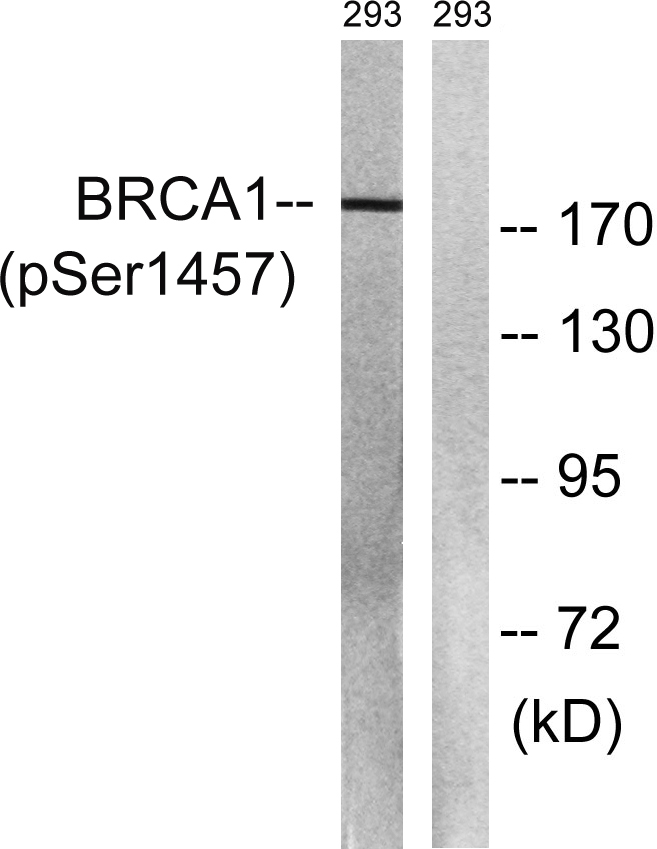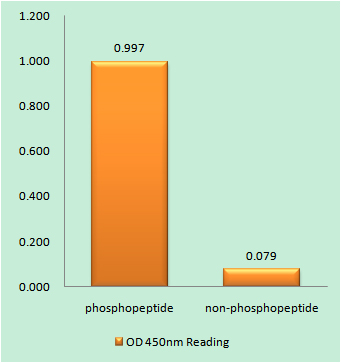Total BRCA1 Cell-Based Colorimetric ELISA Kit
- 货号:KA3052C
- 应用:ELISA
- 种属:Human
- 其他名称:
- Breast cancer type 1 susceptibility protein (EC 6.3.2.-) (RING finger protein 53)
- 背景:
- disease:Defects in BRCA1 are a cause of genetic susceptibility to breast cancer (BC) [MIM:113705, 114480]. BC is an extremely common malignancy, affecting one in eight women during their lifetime. A positive family history has been identified as major contributor to risk of development of the disease, and this link is striking for early-onset breast cancer. Mutations in BRCA1 are thought to be responsible for 45% of inherited breast cancer. Moreover, BRCA1 carriers have a 4-fold increased risk of colon cancer, whereas male carriers face a 3-fold increased risk of prostate cancer. Cells lacking BRCA1 show defects in DNA repair by homologous recombination.,disease:Defects in BRCA1 are a cause of genetic susceptibility to ovarian cancer [MIM:113705].,disease:Defects in BRCA1 are a cause of susceptibility to familial breast-ovarian cancer type 1 (BROVCA1) [MIM:604370]. Mutations in BRCA1 are thought to be responsible for more than 80% of inherited breast-ovarian cancer.,domain:The BRCT domains recognize and bind phosphorylated pSXXF motif on proteins. The interaction with the phosphorylated pSXXF motif of FAM175A/Abraxas, recruits BRCA1 at DNA damage sites.,domain:The RING-type zinc finger domain interacts with BAP1.,function:The BRCA1-BARD1 heterodimer coordinates a diverse range of cellular pathways such as DNA damage repair, ubiquitination and transcriptional regulation to maintain genomic stability. Acts by mediating ubiquitin E3 ligase activity that is required for its tumor suppressor function. Plays a central role in DNA repair by facilitating cellular response to DNA repair. Required for appropriate cell cycle arrests after ionizing irradiation in both the S-phase and the G2 phase of the cell cycle. Involved in transcriptional regulation of P21 in response to DNA damage. Required for FANCD2 targeting to sites of DNA damage. May function as a transcriptional regulator. Inhibits lipid synthesis by binding to inactive phosphorylated ACACA and preventing its dephosphorylation.,online information:BRCA1 entry,online information:The Singapore human mutation and polymorphism database,pathway:Protein modification; protein ubiquitination.,polymorphism:There is evidence that the presence of the rare form of Gln-356-Arg and Leu-871-Pro polymorphisms may be associated with an increased risk for developing ovarian cancer.,PTM:Phosphorylated in response to IR, UV, and various stimuli that cause checkpoint activation, probably by ATM or ATR.,similarity:Contains 1 RING-type zinc finger.,similarity:Contains 2 BRCT domains.,subcellular location:Localizes at sites of DNA damage at double-strand breaks (DSBs); recruitment to DNA damage sites is mediated by the BRCA1-A complex.,subunit:Part of the BRCA1-associated genome surveillance complex (BASC), which contains BRCA1, MSH2, MSH6, MLH1, ATM, BLM, PMS2 and the RAD50-MRE11-NBN protein complex. This association could be a dynamic process changing throughout the cell cycle and within subnuclear domains. Component of the BRCA1-A complex, at least composed of the BRCA1, BARD1, UIMC1/RAP80, FAM175A/Abraxas, BRCC3/BRCC36, BRE/BRCC45 and MERIT40/NBA1. Interacts (via BRCT domains) with FAM175A/Abraxas and RBBP8. Associates with RNA polymerase II holoenzyme. Interacts with SMC1A and COBRA1/NELFB. Interacts (via BRCT domains) with BRIP1. Interacts with FANCD2 (ubiquitinated). Interacts with BAP1. Interacts with DCLRE1C/Artemis and CLSPN. Interacts with H2AFX (phosphorylated on 'Ser-140'). Interacts with CHEK1/CHK1. Interacts with BRCC3. Interacts (via BRCT domains) with ACACA (phosphorylated); the interaction prevents dephosphorylation of ACACA.,tissue specificity:Isoform 1 and isoform 3 are widely expressed. Isoform 3 is reduced or absent in several breast and ovarian cancer cell lines.,
- 功能:
- cell cycle checkpoint, DNA damage checkpoint, microtubule cytoskeleton organization, double-strand break repair via homologous recombination, recombinational repair, DNA metabolic process, DNA replication, DNA repair, regulation of DNA repair, postreplication repair, double-strand break repair, DNA recombination, regulation of transcription, DNA-dependent, regulation of transcription from RNA polymerase II promoter, regulation of transcription from RNA polymerase III promoter, proteolysis, fatty acid metabolic process, fatty acid biosynthetic process, apoptosis, induction of apoptosis, response to DNA damage stimulus, DNA damage response, signal transduction by p53 class mediator resulting in transcription of p21 class mediator, cytoskeleton organization, microtubule-based process, cell cycle,chromosome segregation, centrosome cycle, intracellular signaling cascade, dosage compensation,
- 细胞定位:
- Nucleus . Chromosome . Cytoplasm . Localizes at sites of DNA damage at double-strand breaks (DSBs); recruitment to DNA damage sites is mediated by ABRAXAS1 and the BRCA1-A complex (PubMed:26778126). Translocated to the cytoplasm during UV-induced apoptosis (PubMed:20160719). .; [Isoform 3]: Cytoplasm.; [Isoform 5]: Cytoplasm .
- 组织表达:
- Isoform 1 and isoform 3 are widely expressed. Isoform 3 is reduced or absent in several breast and ovarian cancer cell lines.


